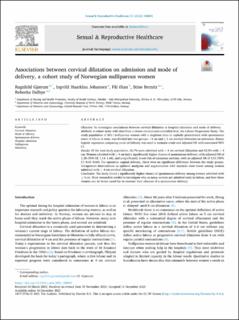Associations between cervical dilatation on admission and mode of delivery, a cohort study of Norwegian nulliparous women
Peer reviewed, Journal article
Published version
Permanent lenke
https://hdl.handle.net/11250/2984091Utgivelsesdato
2021-12-21Metadata
Vis full innførselSamlinger
Originalversjon
https://doi.org/10.1016/j.srhc.2021.100691Sammendrag
Objective: To investigate associations between cervical dilatation at hospital admission and mode of delivery.
Methods: A cohort study with data from a cluster-randomised controlled trial, the Labour Progression Study. The study population of 6511 nulliparous women with a singleton fetus in cephalic presentation with spontaneous onset of labour at term, was divided into two groups: <4 cm and ≥ 4 cm cervical dilatation on admission. Binary logistic regression comparing mode of delivery was used to estimate crude and adjusted OR with associated 95% CI.
Results: Of the total study population, 56.7% were admitted with < 4 cm cervical dilatation and 43.3% with ≥ 4 cm. Women admitted with ≥ 4 cm had a significantly higher chance of spontaneous delivery, with adjusted OR of 1.28 (95% CI: 1.14–1.44), and a significantly lower risk of caesarean sections, with an adjusted OR of 0.51 (95% CI: 0.41–0.64). For operative vaginal delivery, there were no significant difference between the study groups. Intrapartum interventions as epidural analgesia and augmentation with oxytocin were lower among women admitted with ≥ 4 cm cervical dilatation.
Conclusion: The study found a significantly higher chance of spontaneous delivery among women admitted with ≥ 4 cm. More research is needed to investigate why so many women are admitted early in labour, and how these women can be better cared for to increase their chances of a spontaneous delivery.

